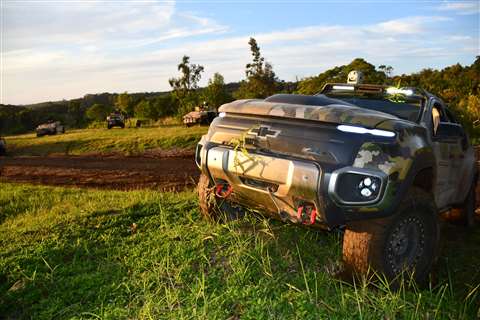U.S. Army unveils first Climate Strategy
09 February 2022
The U.S. Army has announced the release of its first Climate Strategy that will guide decision-making in response to threats from climate that affect installation and unit sustainability, readiness and resilience.
As a guide for future decisions, this strategy is the next step in the Army’s decades-long effort to combat climate change in support of national security interests.
 The U.S. Army’s ZH2 fuel-cell electric demonstrator vehicle during a training exercise. The Army is looking to use more electric and fuel cell vehicles in the future as part of its newly announced Climate Strategy. (Photo: U.S. Army)
The U.S. Army’s ZH2 fuel-cell electric demonstrator vehicle during a training exercise. The Army is looking to use more electric and fuel cell vehicles in the future as part of its newly announced Climate Strategy. (Photo: U.S. Army)
“The time to address climate change is now,” said Secretary of the Army, Christine Wormuth. “The effects of climate change have taken a toll on supply chains, damaged our infrastructure, and increased risks to Army Soldiers and families due to natural disasters and extreme weather.
“The Army must adapt across our entire enterprise and purposefully pursue greenhouse gas mitigation strategies to reduce climate risks. If we do not take action now, across our installations, acquisition and logistics, and training, our options to mitigate these risks will become more constrained with each passing year.”
The Army developed its Climate Strategy as a roadmap of actions that will include efforts to use less fossil fuel in the Army’s non-tactical vehicle (NTV) fleet. The Army said that through the end of 2020, it has removed 18,000 fossil fuel NTVs from its fleet while increasing its inventory of hybrid vehicles by almost 3000 in the last three years. The changes have decreased NTV fleet costs by over $50 million, slashed Army fossil fuel consumption by more than 13 million gallons per year and reduced the service’s GHG emissions per mile by over 12%.
The Army said it will continue its transition to zero-emissions vehicles, enabled by new policies like Army Materiel Command’s (AMC) September 2021 mandate that all new vehicle leases, lease renewals, and purchases for AMC missions must select all-electric NTVs first, hybrids when electric solutions are not commercially available and conventional gas vehicles by exception only. The service aims to field an all-electric light-duty NTV fleet by 2027 and use hybrid options as a bridging solution to field an all-electric Army NTV fleet by 2035.
In 2022, the Army will also invest in over 470 charging stations. All garrison commanders will work with industry and utility suppliers to determine how best to expand electric vehicle charging infrastructure on every Army installation.
To read the complete U.S. Army Climate Strategy, click
.
STAY CONNECTED




Receive the information you need when you need it through our world-leading magazines, newsletters and daily briefings.
POWER SOURCING GUIDE
The trusted reference and buyer’s guide for 83 years
The original “desktop search engine,” guiding nearly 10,000 users in more than 90 countries it is the primary reference for specifications and details on all the components that go into engine systems.
Visit Now
CONNECT WITH THE TEAM









